论领导艺术,中英翻译对照
- 格式:doc
- 大小:20.50 KB
- 文档页数:1
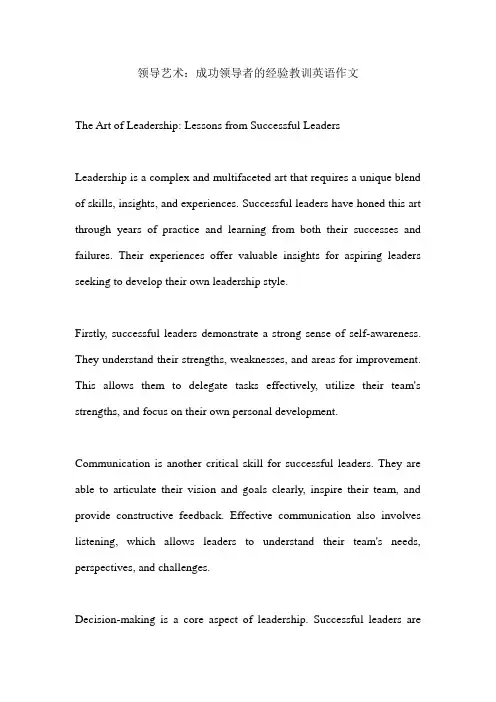
领导艺术:成功领导者的经验教训英语作文The Art of Leadership: Lessons from Successful LeadersLeadership is a complex and multifaceted art that requires a unique blend of skills, insights, and experiences. Successful leaders have honed this art through years of practice and learning from both their successes and failures. Their experiences offer valuable insights for aspiring leaders seeking to develop their own leadership style.Firstly, successful leaders demonstrate a strong sense of self-awareness. They understand their strengths, weaknesses, and areas for improvement. This allows them to delegate tasks effectively, utilize their team's strengths, and focus on their own personal development.Communication is another critical skill for successful leaders. They are able to articulate their vision and goals clearly, inspire their team, and provide constructive feedback. Effective communication also involves listening, which allows leaders to understand their team's needs, perspectives, and challenges.Decision-making is a core aspect of leadership. Successful leaders areable to make sound decisions quickly and confidently, balancing risks and rewards. They understand the importance of gathering information, consulting with their team, and considering all options before making a decision.Successful leaders also demonstrate adaptability and flexibility. They are able to adjust their strategies and plans in response to changing conditions and new information. This requires a willingness to learn, embrace change, and stay current with industry trends.Moreover, successful leaders build trust and foster a positive team culture. They demonstrate integrity, fairness, and respect for their team members. They create an environment where everyone feels valued and empowered to contribute their ideas and expertise.Lastly, successful leaders inspire and motivate their team. They believe in their team's abilities and potential, providing encouragement and support when needed. They celebrate successes and learn from failures, fostering a culture of continuous improvement and growth.In conclusion, leadership is an art that requires constant learning and refinement. Successful leaders demonstrate a strong sense ofself-awareness, effective communication skills, sound decision-making abilities, adaptability, trust-building, and inspiration. Aspiring leaders can learn from these experiences and apply them to their own leadership journey.领导艺术:成功领导者的经验教训领导力是一门复杂而多面的艺术,需要独特的技能、见解和经验。
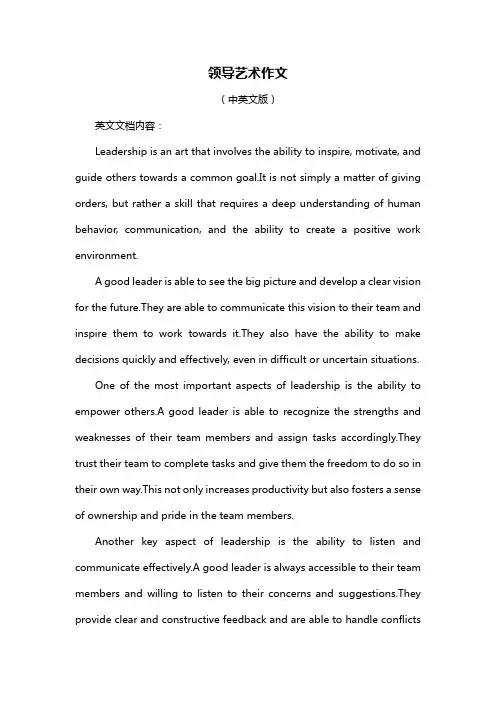
领导艺术作文(中英文版)英文文档内容:Leadership is an art that involves the ability to inspire, motivate, and guide others towards a common goal.It is not simply a matter of giving orders, but rather a skill that requires a deep understanding of human behavior, communication, and the ability to create a positive work environment.A good leader is able to see the big picture and develop a clear vision for the future.They are able to communicate this vision to their team and inspire them to work towards it.They also have the ability to make decisions quickly and effectively, even in difficult or uncertain situations.One of the most important aspects of leadership is the ability to empower others.A good leader is able to recognize the strengths and weaknesses of their team members and assign tasks accordingly.They trust their team to complete tasks and give them the freedom to do so in their own way.This not only increases productivity but also fosters a sense of ownership and pride in the team members.Another key aspect of leadership is the ability to listen and communicate effectively.A good leader is always accessible to their team members and willing to listen to their concerns and suggestions.They provide clear and constructive feedback and are able to handle conflictsor issues that may arise in the team.Lastly, a good leader is someone who is able to lead by example.They demonstrate qualities such as integrity, dedication, and hard work, which inspires their team members to follow suit.They are also not afraid to take responsibility for their mistakes and learn from them.In conclusion, leadership is an art that requires a combination of skills, qualities, and attributes.A good leader is able to inspire and motivate their team, communicate effectively, make decisions quickly, empower others, and lead by example.With practice and experience, anyone can develop these skills and become an effective leader.中文文档内容:领导艺术是一种涉及激励、激励和引导他人共同实现目标的能力。

牡丹江医学院教案
牡丹江医学院教案
牡丹江医学院教案
牡丹江医学院教案
牡丹江医学院教案
牡丹江医学院教案
牡丹江医学院教案
牡丹江医学院教案
牡丹江医学院教案
牡丹江医学院教案牡丹江医学院教案
牡丹江医学院教案牡丹江医学院教案
牡丹江医学院教案
牡丹江医学院教案
牡丹江医学院教案牡丹江医学院教案
牡丹江医学院教案
牡丹江医学院教案
牡丹江医学院教案牡丹江医学院教案
牡丹江医学院教案
牡丹江医学院教案
牡丹江医学院教案牡丹江医学院教案
牡丹江医学院教案
牡丹江医学院教案
牡丹江医学院教案牡丹江医学院教案
牡丹江医学院教案
牡丹江医学院教案
牡丹江医学院教案
牡丹江医学院教案。
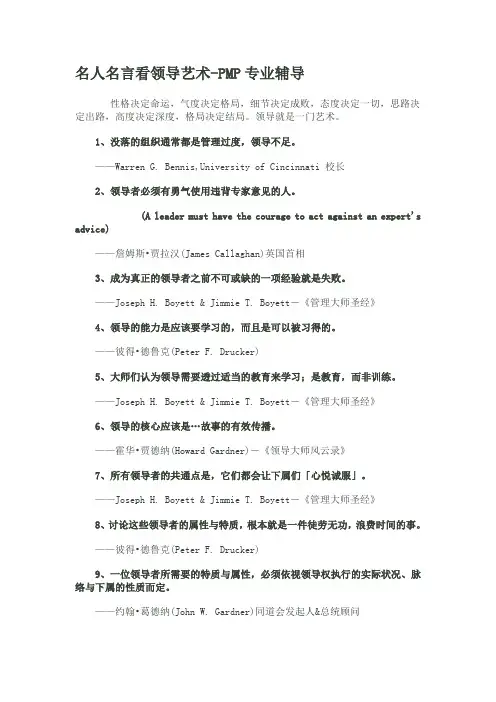
名人名言看领导艺术-PMP专业辅导性格决定命运,气度决定格局,细节决定成败,态度决定一切,思路决定出路,高度决定深度,格局决定结局。
领导就是一门艺术。
1、没落的组织通常都是管理过度,领导不足。
——Warren G. Bennis,University of Cincinnati 校长2、领导者必须有勇气使用违背专家意见的人。
(A leader must have the courage to act against an expert's advice)——詹姆斯•贾拉汉(James Callaghan)英国首相3、成为真正的领导者之前不可或缺的一项经验就是失败。
——Joseph H. Boyett & Jimmie T. Boyett―《管理大师圣经》4、领导的能力是应该要学习的,而且是可以被习得的。
——彼得•德鲁克(Peter F. Drucker)5、大师们认为领导需要透过适当的教育来学习;是教育,而非训练。
——Joseph H. Boyett & Jimmie T. Boyett―《管理大师圣经》6、领导的核心应该是…故事的有效传播。
——霍华•贾德纳(Howard Gardner)―《领导大师风云录》7、所有领导者的共通点是,它们都会让下属们「心悦诚服」。
——Joseph H. Boyett & Jimmie T. Boyett―《管理大师圣经》8、讨论这些领导者的属性与特质,根本就是一件徒劳无功,浪费时间的事。
——彼得•德鲁克(Peter F. Drucker)9、一位领导者所需要的特质与属性,必须依视领导权执行的实际状况、脉络与下属的性质而定。
——约翰•葛德纳(John W. Gardner)同道会发起人&总统顾问10、若是瞎子领导瞎子,则两人都要掉进坑裡。
——马太福音第十五张第十四节11、领导者聪明与否不重要;重要的是是否认真做事。
——彼得•德鲁克(Peter F. Drucker)-《经理人的专业与挑战》12、领袖是天生的,错。
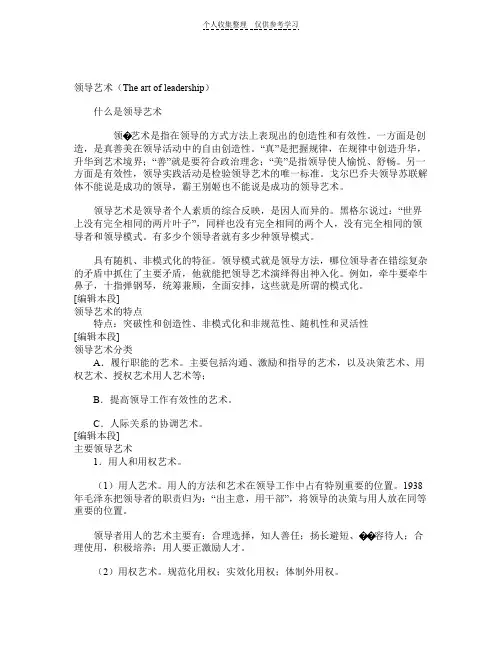
领导艺术(The art of leadership)什么是领导艺术领�艺术是指在领导的方式方法上表现出的创造性和有效性。
一方面是创造,是真善美在领导活动中的自由创造性。
“真”是把握规律,在规律中创造升华,升华到艺术境界;“善”就是要符合政治理念;“美”是指领导使人愉悦、舒畅。
另一方面是有效性,领导实践活动是检验领导艺术的唯一标准。
戈尔巴乔夫领导苏联解体不能说是成功的领导,霸王别姬也不能说是成功的领导艺术。
领导艺术是领导者个人素质的综合反映,是因人而异的。
黑格尔说过:“世界上没有完全相同的两片叶子”,同样也没有完全相同的两个人,没有完全相同的领导者和领导模式。
有多少个领导者就有多少种领导模式。
具有随机、非模式化的特征。
领导模式就是领导方法,哪位领导者在错综复杂的矛盾中抓住了主要矛盾,他就能把领导艺术演绎得出神入化。
例如,牵牛要牵牛鼻子,十指弹钢琴,统筹兼顾,全面安排,这些就是所谓的模式化。
[编辑本段]领导艺术的特点特点:突破性和创造性、非模式化和非规范性、随机性和灵活性[编辑本段]领导艺术分类A.履行职能的艺术。
主要包括沟通、激励和指导的艺术,以及决策艺术、用权艺术、授权艺术用人艺术等;B.提高领导工作有效性的艺术。
C.人际关系的协调艺术。
[编辑本段]主要领导艺术1.用人和用权艺术。
(1)用人艺术。
用人的方法和艺术在领导工作中占有特别重要的位置。
1938 年毛泽东把领导者的职责归为:“出主意,用干部”,将领导的决策与用人放在同等重要的位置。
领导者用人的艺术主要有:合理选择,知人善任;扬长避短、��容待人;合理使用,积极培养;用人要正激励人才。
(2)用权艺术。
规范化用权;实效化用权;体制外用权。
(3)授权艺术。
包括合理选择授权方式;授权留责(领导者将权力授予下级后,下级在工作中出问题,级负责任,领导也应负领导责任,士卒犯罪,过及主帅。
);视能授权(领导者向下级授权,授什么权,授多权,应根据下级能力的高低而定。
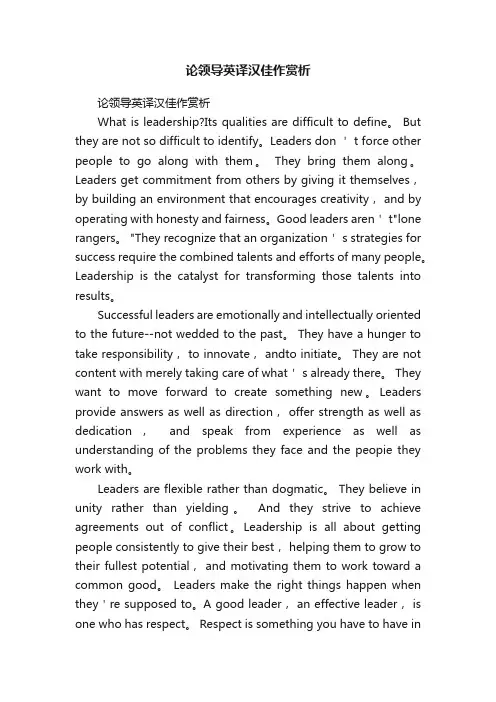
论领导英译汉佳作赏析论领导英译汉佳作赏析What is leadership?Its qualities are difficult to define。
But they are not so difficult to identify。
Leaders don ' t force other people to go along with them。
They bring them along。
Leaders get commitment from others by giving it themselves,by building an environment that encourages creativity, and by operating with honesty and fairness。
Good leaders aren' t"lone rangers。
"They recognize that an organization' s strategies for success require the combined talents and efforts of many people。
Leadership is the catalyst for transforming those talents into results。
Successful leaders are emotionally and intellectually oriented to the future--not wedded to the past。
They have a hunger to take responsibility, to innovate, andto initiate。
They are not content with merely taking care of what' s already there。
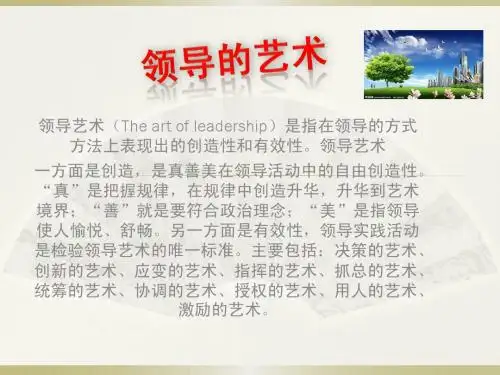
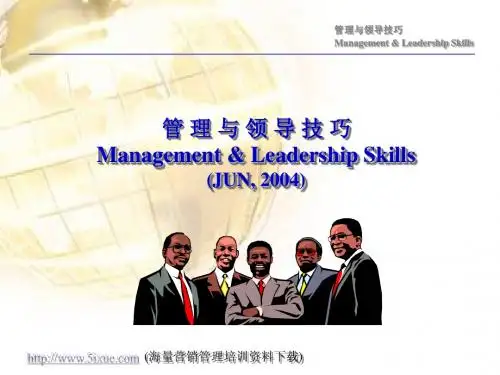
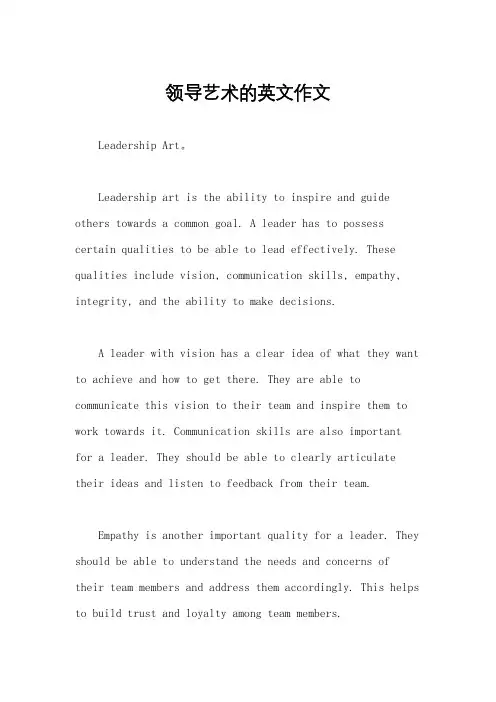
领导艺术的英文作文Leadership Art。
Leadership art is the ability to inspire and guide others towards a common goal. A leader has to possess certain qualities to be able to lead effectively. These qualities include vision, communication skills, empathy, integrity, and the ability to make decisions.A leader with vision has a clear idea of what they want to achieve and how to get there. They are able to communicate this vision to their team and inspire them to work towards it. Communication skills are also importantfor a leader. They should be able to clearly articulate their ideas and listen to feedback from their team.Empathy is another important quality for a leader. They should be able to understand the needs and concerns oftheir team members and address them accordingly. This helps to build trust and loyalty among team members.Integrity is also crucial for a leader. They should be honest, transparent, and ethical in their actions. This sets a good example for their team and helps to build a culture of trust and respect.Finally, a leader should be able to make decisions confidently and effectively. They should be able to weigh the pros and cons of different options and make a decision that is in the best interest of the team and the organization.In addition to these qualities, there are also certain leadership styles that a leader can adopt. These include autocratic, democratic, and laissez-faire. Autocratic leaders make decisions on their own without consulting their team. Democratic leaders involve their team in the decision-making process. Laissez-faire leaders give their team members a lot of freedom to make decisions on their own.Each leadership style has its own advantages anddisadvantages. It is up to the leader to choose the style that best suits their team and the situation at hand.In conclusion, leadership art is an essential skill for anyone who wants to lead effectively. A good leader should possess certain qualities such as vision, communication skills, empathy, integrity, and the ability to make decisions. They should also be able to adopt the leadership style that best suits their team and the situation at hand. With these skills and qualities, a leader can inspire and guide their team towards success.。
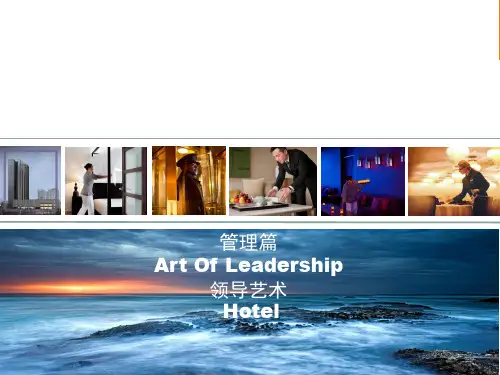
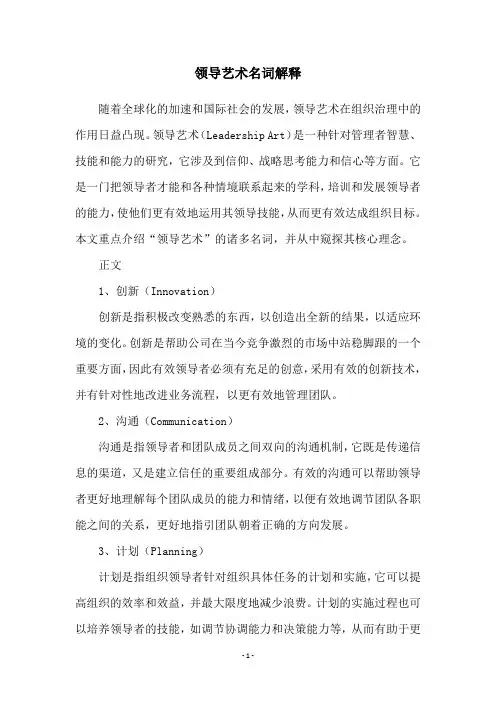
领导艺术名词解释随着全球化的加速和国际社会的发展,领导艺术在组织治理中的作用日益凸现。
领导艺术(Leadership Art)是一种针对管理者智慧、技能和能力的研究,它涉及到信仰、战略思考能力和信心等方面。
它是一门把领导者才能和各种情境联系起来的学科,培训和发展领导者的能力,使他们更有效地运用其领导技能,从而更有效达成组织目标。
本文重点介绍“领导艺术”的诸多名词,并从中窥探其核心理念。
正文1、创新(Innovation)创新是指积极改变熟悉的东西,以创造出全新的结果,以适应环境的变化。
创新是帮助公司在当今竞争激烈的市场中站稳脚跟的一个重要方面,因此有效领导者必须有充足的创意,采用有效的创新技术,并有针对性地改进业务流程,以更有效地管理团队。
2、沟通(Communication)沟通是指领导者和团队成员之间双向的沟通机制,它既是传递信息的渠道,又是建立信任的重要组成部分。
有效的沟通可以帮助领导者更好地理解每个团队成员的能力和情绪,以便有效地调节团队各职能之间的关系,更好地指引团队朝着正确的方向发展。
3、计划(Planning)计划是指组织领导者针对组织具体任务的计划和实施,它可以提高组织的效率和效益,并最大限度地减少浪费。
计划的实施过程也可以培养领导者的技能,如调节协调能力和决策能力等,从而有助于更好地完成任务,更有效地实现组织目标。
4、行动(Action)行动指的是组织领导者实施计划的行动,它是领导者从理论到行动的最后一步。
行动是领导者将理念转化为实际行动的重要组成部分,只有行动才能促进实践,实现组织目标,它是领导者有效实施计划的基础和关键。
5、责任(Responsibility)责任指的是领导者有效落实员工与组织的联系,将其承诺转化为实际行动,从而促进有效的工作绩效。
责任是领导者实施行动的重要组成部分,因为只有负责任的责任,才能让员工确信领导者真正关心大家,并真正对员工的表现和成果负责。
6、结果(Result)结果指的是领导者实施计划、行动所取得的目标,它是领导者实现组织目标的基本因素。
The art of leadership领导的艺术In his 1989 book, The New Realities, the late Peter Drucker, described management as a ―liberal art‖–that is, the application of knowledge, self-knowledge and wisdom to achieve an effective result. The context, argued Drucker, the first serious chronicler of modern business, was that management, ubiquitous and essential for any kind of human endeavour, had become a social and not just a business function. Redefining management in this way, drawing on the insights of the humanities to illuminate present needs and how to meet them, would help solve the existential crisis brought on by management‘s very success: what gives it its legitimacy? To whom is it accountable, and for what?彼得•德鲁克(Peter Drucker,已于2005年去世)在其1989年出版的《管理新现实》(The New Realities)一书中将管理学称为一门―通识学科‖——也就是说,这门学问运用知识、自我认知和智慧来获得有效结果。
领导的艺术的英语作文Title: The Art of Leadership。
Leadership is an intricate art form that requires finesse, vision, and empathy. It is a skill set that not only directs the course of action but also inspires and empowers individuals towards a common goal. In this essay, we will delve into the nuances of leadership, exploring its various dimensions and the qualities that define effective leadership.First and foremost, effective leadership entails possessing a clear vision. A leader must have a keen understanding of where they want to go and be able to articulate this vision in a compelling manner to others. This clarity of purpose serves as a guiding light, steering both the leader and their team through challenges and uncertainties. Without a vision, a leader risks aimless wandering and a lack of direction, ultimately leading to disarray and inefficiency.Furthermore, communication skills are paramount in the art of leadership. A leader must be able to convey their vision and expectations effectively to their team members. This involves not only speaking clearly but also listening attentively. By fostering open communication channels, a leader can gain valuable insights, build trust, and ensure that everyone feels heard and valued. Additionally,effective communication facilitates collaboration and promotes a sense of unity among team members, fostering a conducive environment for productivity and innovation.Empathy is another essential component of effective leadership. A leader must be able to understand and relateto the experiences, emotions, and perspectives of thosethey lead. By demonstrating empathy, a leader can forge meaningful connections with their team members, foster a supportive work culture, and inspire loyalty and dedication. Moreover, empathy enables a leader to anticipate the needs and concerns of their team, allowing them to provide the necessary support and guidance.In addition to vision, communication, and empathy, integrity is a fundamental quality of effective leadership.A leader must act with honesty, transparency, and moral courage, earning the trust and respect of their team members. Integrity is the cornerstone of credibility, and without it, a leader's influence and effectiveness are severely compromised. By upholding ethical principles and leading by example, a leader sets the standard for behavior within the organization, fostering a culture of trust, accountability, and integrity.Adaptability is also crucial in the art of leadership, especially in today's rapidly changing world. A leader must be flexible and responsive, capable of navigating uncertainty and adapting to new circumstances and challenges. This requires a willingness to embrace change, learn from failures, and continuously evolve strategies and approaches. A rigid and inflexible leader risks becoming obsolete in a dynamic and ever-evolving environment.Moreover, effective leadership involves empowering others and fostering leadership potential within the team.A leader should mentor, coach, and develop their team members, nurturing their skills, talents, and aspirations. By empowering others, a leader not only strengthens the team but also ensures continuity and sustainability beyond their own tenure. True leadership is not about wielding power or authority but about empowering others to reach their full potential and achieve collective success.In conclusion, the art of leadership encompasses a myriad of qualities and skills, from vision and communication to empathy and integrity. Effective leadership is not merely about directing others but about inspiring, empowering, and guiding them towards a shared vision and common goals. By cultivating these qualities and mastering the art of leadership, individuals can make a positive impact on their organizations, communities, and the world at large.。
领导艺术的七把斧领导艺术The art of leader ship是指在领导的方式方法上表现出的创造性和有效性,领导艺术是领导者个人素质的综合反映。
一方面是创造,是真善美在领导活动中的自由创造性。
“真”是把握规律,在规律中创造升华,升华到艺术境界;“善”就是要符合政治理念;“美”是指领导使人愉悦、舒畅。
另一方面是有效性,领导实践活动是检验领导艺术的唯一标准。
今天笔者总结。
沉稳谁能真正成功?是那些不为人所知的“沉静领导”,他们的共同特点是:内向、低调、坚韧、平和,甚至动机混杂。
沉静领导具有3大品格特征:低调、克制、谦虚和执着。
低调、沉静的领导之道,与传统的东方处事哲学很相近,令中国企业领导者所思:这是不是管理思想的返璞归真。
一位卓越的企业领导者,不见得必须是叱咤风云的领导大腕。
沉着的领导者纷纷用实力证明:不必大声喧哗,也能让世人看见卓越。
艾森豪威尔曾引用拿破仑的一句话来为“领导”**脚:“领导就是当你身边的人忙得发疯,又或者变得歇斯底里的时候,你仍然能沉着和正常地工作。
”细心领导者应抓大事,但是对于一些看似不起眼的细节也不能忽视。
大事由小事组成,小事影响着大事的走向。
小事能从一定角度反映出事物的本质,对事物发展的结果起关键作用。
所以细节决定成败不是小题大做。
领导者必须看重小事,认真对待和处理小事。
有时领导者恰是因为在细节上出了问题,而影响整体形象,造成难以挽回的不良后果。
领导者一句随意的话,一个小动作都可以反映领导者的自身修养,进而折射出一个单位的整体形象。
领导干部身为表率,代表的是党和政府的形象,他们要与各行各业的人交流、沟通,若言语失当,小则丢失颜面,大则影响党的正面形象。
胆识在今天的商界,胆商更显示出其特有的作用,胆商就是胆识能力,即挑战、竞争和冒险的能力。
对于一个想成就一番事业的人来说,胆识的作用是不可替代的,甚至是起决定性作用的。
所以,创业,就要胆大!前怕狼后怕虎你永远不要想创业成功!积极人的精神动力,表现为人做事的欲望、积极性、意志力。
论领导艺术
什么是领导艺术?
其性质难以定义,但却并不难理解。
领袖们并不强迫其他人听从,但他们引导其他人听从。
领袖们通过要求自己,构建一种鼓励创造性的环境,实行诚实和公正来获得他人的承诺。
领袖们不仅严以律己,而且严以待人。
他们野心勃勃,他们对下属寄予厚望,他们力图激发出下属的全部才能。
好的领袖并非“独行侠”。
好的领袖清楚的知道,集体的才智和努力对于一个组织的成功是何其重要。
而领导艺术就是一种催化剂,一种让梦想照进现实的催化剂。
当对一个问题有两个观点的时候,其中一个并不一定是错误的。
领袖们明白激进意味着肤浅。
他们接受新观点,并会彻底地摸清分歧之所在。
成功的领袖是理性与感性并存的,他们拥抱未来,却从不执着于过去。
他们肩负着创新和发展的责任。
他们并不仅仅满足于现状,他们更期盼于去创造现在所没有的。
领袖的回答相当于指导,优势相当于奉献,凭经验而论相当于知己知彼。
领袖们易变通,而不武断;崇尚统一,而非从众;追求共识,而非争论。
领导艺术让周围的人共同获利,帮助他们充分地发挥潜能,激励他们向集体利益而努力。
领袖们料事如神。
一个拥有好的领导力的领袖,是对被人给予尊重的人。
尊重就是某些为了去获得而不得不拥有的东西。
一个领导者,必定尊重一个组织中的各个阶层的人,尊重他们所做的工作,尊重他们的才能、愿望和需求。
而这些尊重,必将返还到领导者的身上,这些关注,必将激发工作的积极性。